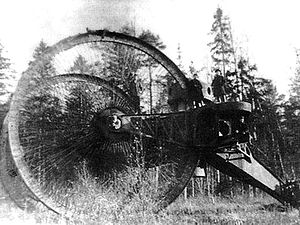Tíotán tank
The Tíotán, or Titan landship or Falway's Failure, was an experimental armored vehicle used in the later half of the Fhainnin Civil War. It was designed as a siege engine to circumvent tracks blown out to limit the Republican's use of armored trains. Overall, four were constructed. The design was noted as one of the earliest tanks to see combat service in spite of its poor performance.
| Tíotán | |
|---|---|
 Prototype of the Titan. | |
| Type | Landship |
| Place of origin | Faneria |
| Service history | |
| In service | 1908-1915 |
| Wars | Fhainnin Civil War |
| Production history | |
| Designer | Gregory Felway |
| Designed | 1908 |
| Manufacturer | Madrat Motor Design |
| Produced | 1908-1910 |
| No. built | 4 |
| Variants |
|
| Specifications | |
| Mass | 58 tons |
| Length | 60 ft |
| Width | 38.5 ft |
| Height | 30 ft |
| Crew | 7 (commander, 2 gunners, 2 loaders, signals operator, engineer) |
Main armament |
|
| Engine | Dual Madrat 3600 Automobile engines 520 hp |
Operational range | 6 miles |
| Maximum speed |
|
Design and Manufacture
The original Titan chassis was designed entirely by Gregory Felway, a motor engineer working on armored trains for the Revolutionary Peoples' Army. Felway was present at the Siege of Rihsport, where Royalist forces had effectively delayed the trais used by the RPA by destroying tracks. Felway came up with the Titan as a 'trackless train', intended to carry artillery and heavy machine guns across dry ground to support advancing infantry. Madrat Motor Design agreed to produce two prototypes, which were assembled on-site near Kurikila. One additional model was produced before the design flaws of the machine became apparent, after which a single modified Titan 2 was produced.
The Titan 1 featured a tricycle design, with two enormous wheels drifing the vehicle and a third stabilizing the carriage. The carriage extended to two sponsons just past the arms holding the drive wheels. Originally, the carriage was intended to hold a single artillery peice, but this was expanded with the artillery being moved to the sponsons and a stationary turret on the dorsal side of the carriage being added. The turret bore four machine guns, although these were removed and added as available throughout service due to shortages.
The Titan 2 fixed many of the most egregious failings of the Titan 1, including a larger, dual-wheel stabilizer and a rearrangement of the armament; a single artillery gun was placed in the top turret and the sponsons were given machine guns with a swivel system to give them a wider field of fire, with the main cabin being fitted as a commander's room and storage for ammunition and equipment to deal with the cramped and inefficient crew setup of the Titan 1. This had the added effect of reducing the crew from 11 to 7 while increasing crew maneuverability within the landship.
Service History
Two Titan 1s were delivered to the RPA outside of Kurikila in late 1980, where they were assembled under an engineer's supervision and deployed for the first time. Both models lasted only a short while, with one cracking its drive axle and a sheel strut after slipping down a short hill and the other's stabilizer wheel, which was much too small for muddy terrain, getting stuck in mud and recieving a barrage of artillery fire which obliterated it the next day. A third Titan 1 had been produced but was never assembled, instead being used as spare parts for the singular Titan 2.
The Titan 2 served much more effectively in spite of its reduced armament due to its redesign, supporting an infantry assault at Dunderrow in 1909 just prior to the end of organized Royalist resistance. It suffered minor damage but remained operational, and was disassembled and returned to the south, where it became a propaganda piece. However, it had proven immensely cost-ineffective, and the earlier failure of the program along with the introduction of continuous tracks quickly made it obsolete. The Titan 2 was removed from propaganda service in 1915 and stored until 1997, when it was refurbished as a museum piece.